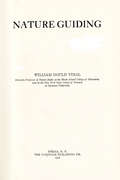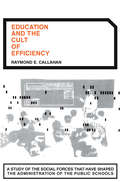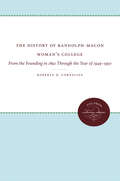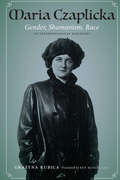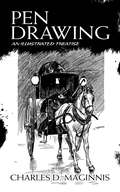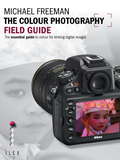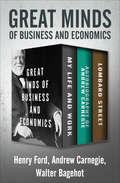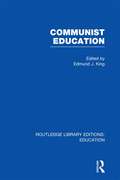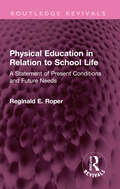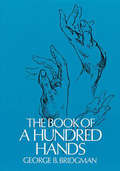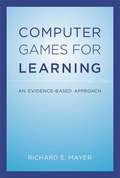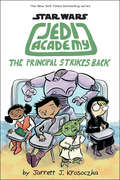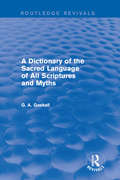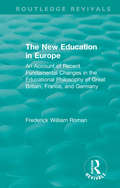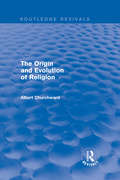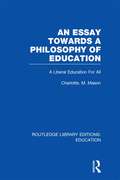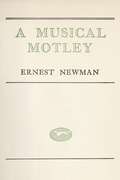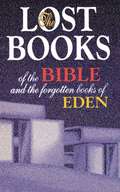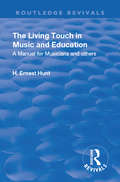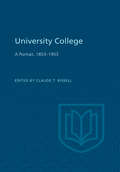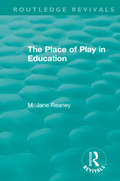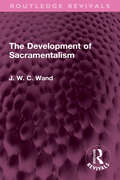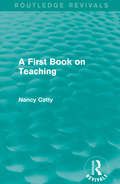- Table View
- List View
Nature Guiding
by William Gould VinalNature Guiding is the science of inculcating nature enthusiasm, nature principles, and nature facts into the spirit of individuals. "Doing" nature-study means observing, wondering, and solving problems. It could include collecting, building, measuring, painting, planning, writing, touching, experimenting or any of a wide range of other activities. Most importantly, it allows children to be "original investigators."This book is intended as a resource for teachers and students engaged in nature study at summer camps and in schools. William Gould Vinal believed that the teacher of nature study should be "in sympathy with the simple life and the country way," that the nature study should emphasize observation of the interactions of plants and animals in their environment, and not be reduced to matters of taxonomy and anatomy. In Nature Guiding, he offers advice to camp counselors and school teachers on incorporating nature study into everyday activities, as well as suggestions for parents and others about using visits to state and national parks to teach nature lore.
Education and the Cult of Efficiency
by Raymond E. CallahanRaymond Callahan's lively study exposes the alarming lengths to which school administrators went, particularly in the period from 1910 to 1930, in sacrificing educational goals to the demands of business procedures. He suggests that even today the question still asked is: "How can we operate our schools?" Society has not yet learned to ask: "How can we provide an excellent education for our children?"
The History of Randolph-Macon Woman's College: From the Founding in 1891 Through the Year of 1949-1950
by Roberta D. CorneliusThe history of Randolph-Macon Woman's College has a claim upon the attention of all who are interested in the education and achievement of women. Its course through the years is set forth in the present volume, in which the author has dealt with the pattern of life developed in the cultivation of the liberal arts.Originally published in 1951.A UNC Press Enduring Edition -- UNC Press Enduring Editions use the latest in digital technology to make available again books from our distinguished backlist that were previously out of print. These editions are published unaltered from the original, and are presented in affordable paperback formats, bringing readers both historical and cultural value.
Maria Czaplicka: Gender, Shamanism, Race (Critical Studies in the History of Anthropology)
by Grazyna KubicaThis biography of the Polish British anthropologist Maria Czaplicka (1884–1921) is also a cultural study of the dynamics of the anthropological collective presented from a researcher-centric perspective. Czaplicka, together with Bronisław Malinowski, studied anthropology in London and later at Oxford, then she headed the Yenisei Expedition to Siberia (1914–15) and was the first female lecturer of anthropology at Oxford. She was an engaged feminist and an expert on political issues in Northern Asia and Eastern Europe. But this remarkable woman&’s career was cut short by suicide. Like many women anthropologists of the time, Czaplicka journeyed through various academic institutions, and her legacy has been dispersed and her field materials lost. Grażyna Kubica covers the major events in Czaplicka&’s life and provides contextual knowledge about the intellectual formation in which Czaplicka grew up, including the Warsaw radical intelligentsia and the contemporary anthropology of which she became a part. Kubica also presents a critical analysis of Czaplicka&’s scientific and literary works, related to the issues of gender, shamanism, and race. Kubica shows how Czaplicka&’s sense of agency and subjectivity enriched and shaped the practice of anthropology and sheds light on how scientific knowledge arises and is produced.
Pen Drawing: An Illustrated Treatise
by Charles D. MaginnisStyle, materials, techniques, and values are the focus of this richly illustrated guide to pen drawing. In addition to proposing solutions for practical problems, the book offers advice on architectural and decorative drawing. More than 70 drawings by assorted artists range from tranquil churchyards and bustling city streets to striking posters. Many of the images are derived from The Century Magazine, Harper's Magazine, The Architectural Review, and other illustrated periodicals of the early twentieth century.Irish-American architect Charles D. Maginnis (1867-1955), a co-founder of the firm Maginnis & Walsh, was active in the design of ecclesiastical and campus buildings across the United States. He also served as President of the American Institute of Architects from 1937-39. Maginnis' practical guide to pen drawing features several of his own illustrations, created expressly for this instructive volume.
To The Light House
by Virginia Woolf Edited by RL. VARSHNGYAs literature is the reflection of society, so is the writer the product of society. On the one hand he influences society by writing his ideas and thoughts ; on the other hand, he is influenced by a number of factors prevailing in the society. Social and literary conventions, political, economic, educational and religious atmosphere of the society influence him a great deal besides the individuals.
The Colour Photography Field Guide: The Essential Guide To Colour For Striking Digital Images (Field Guide Ser.)
by Michael FreemanDigital cameras and powerful image-processing software applications provide today's photographer with all the tools needed to explore the world of colour. Renowned photographer and author Michael Freeman provides a thorough look at the essential ways of dealing with colour that will help photographers create striking colour digital photographs. Using helpful tips and exercises, he covers everything from capture and calibration to workflow management and output.
Great Minds of Business and Economics: My Life and Work, Autobiography of Andrew Carnegie, and Lombard Street
by Henry Ford Andrew Carnegie Walter BagehotThree classic works on the art of succeeding in business, life, and high finance from three of modern history&’s most influential thought leaders. My Life and Work: A legendary inventor and industrialist, Henry Ford pioneered the American automotive industry. In this combination of memoir and business treatise, he describes his early life as a mechanically inclined farmer&’s son, the inner workings of his eponymous motor company, and the development of the Model T. He also discusses key workplace principles such as compensating workers beyond the prevailing wage and building a diverse workforce. The Autobiography of Andrew Carnegie: Scottish immigrant Andrew Carnegie worked his way up from bobbin boy to telegraph operator to railroad man, learning lessons along the way that would lead to his unparalleled success in the steel industry. In this acclaimed memoir, he shares his story of living the American dream, as well as insights on education, business, and the need to give back for the common good. Lombard Street: Written in response to a nineteenth-century banking crisis in England, Walter Bagehot&’s influential treatise was one of the first to clearly explain complex financial systems in accessible language. As editor in chief of the Economist, Bagehot also makes proposals for strengthening the economy, such as allowing irresponsible banks to collapse and creating strong central banks to combat inflation. His insights are as relevant today as they were when the book was first published in 1873.
Twelfth Night
by William Shakespeare: Edited by Google booksIn this edition of Shakespeare an attempt is made to present the greater plays of the dramatist in their literary aspect, and not merely as material for the study of philology or gramMar. Criticism purely verbal and textual has only been included to such an extent as may serve to help the student in the appreciation of the essential poetry. Questions of date and literary history have been fully dealt with in the Introductions, but the larger space has been devoted to the interpre¬tative rather than the matter-of-fact order of scholar¬ship. ?sthetic judgments are never final, but the Editors have attempted to suggest points of view from which the analysis of dramatic motive and dramatic character may be
Communist Education (Routledge Library Editions: Education)
by Len Barton Martin LawnDevelopments and trends in Communist education are traced in this authoritative survey by specialists. Eight chapters deal with particular aspects: ideology, psychology, the selective process, the roles of teachers and parents, polytechnical education, the universities and professional institutes. Three chapters survey the former East Germany, Poland and China as special case-studies. A concluding chapter examines common ground between Communist and other systems.
Physical Education in Relation to School Life: A Statement of Present Conditions and Future Needs (Routledge Revivals)
by Reginald E. RoperFirst published in 1917, Physical Education in Relation to School Life views the problems of growth and health in relation to education. The main outlines of a satisfactory physical education and its importance are indicated. The author has compared his aims and objectives, and appreciated the practical value of some of the better-known methods of dealing with the problems, and has suggested the direction in which future improvements may most usefully be sought. This book will be of interest to students of physical education, pedagogy and history.
The Book of a Hundred Hands (Dover Anatomy for Artists)
by George B. BridgmanMr. Bridgman states unequivocally in his introduction that before preparing this book he had "not discovered a single volume devoted exclusively to the depicting of the hand." Apparently Mr. Bridgman has appreciated what few others have felt -- the human hand's great capacity for expression and the care that the artist must take to realize it. The hand changes with the age of the person, is shaped differently according to sex, reflects the type of work to which it is put, the physical health, and even the emotions of the person. To represent these distinguishing features, to capture the expressiveness of a particular pair of hands, the artist must understand the construction, anatomy, formation, and function of the hand.There is probably no better instructor to turn to for this understanding than Mr. Bridgman, a well-respected artist who for nearly 50 years lectured and taught at the Art Students League of New York. In this volume, a full text is accompanied by many illustrations depicting virtually every aspect and posture of the human hand. He first considers the back view of the hand, the wrist bones, the tendons, the muscles, the hand bones, the arch, and the veins; and then those of the palm. Throughout he pictures the musculature at work beneath the surface of the skin. He continues by showing how the muscles operate on the thumb side and on the little finger side when each is the center of force; how the thumb and fingers are constructed, their freedom of movement, joints, and complete anatomy as well as views of them straight, bent, and flexed; how the knuckles are formed, what shapes the fist can take and how flexible it can be; and he concludes with illustrations of the total movement, either turning or rotary, of the hand in its various positions.The 100 illustrations the author has selected perfectly define the regions of the hand so that any artist, beginning or experienced, will increase his mastery of it. Better rendering of the human hand is sure to add new expressiveness to your human figures along with new forcefulness and new interest.
Computer Games for Learning
by Richard E. MayerMany strong claims are made for the educational value of computer games, but there is a need for systematic examination of the research evidence that might support such claims. This book fills that need by providing, a comprehensive and up-to-date investigation of what research shows about learning with computer games. Computer Games for Learning describes three genres of game research: the value-added approach, which compares the learning outcomes of students who learn with a base version of a game to those of students who learn with the base version plus an additional feature; the cognitive consequences approach, which compares learning outcomes of students who play an off-the-shelf computer game for extended periods to those of students who do not; and the media comparative approach, which compares the learning outcomes of students who learn material by playing a game to those of students who learn the same material using conventional media. After introductory chapters that describe the rationale and goals of learning game research as well as the relevance of cognitive science to learning with games, the book offers examples of research in all three genres conducted by the author and his colleagues at the University of California, Santa Barbara; meta-analyses of published research; and suggestions for future research in the field. The book is essential reading for researchers and students of educational games, instructional designers, learning-game developers, and anyone who wants to know what the research has to say about the educational effectiveness of computer games.
The Principal Strikes Back (Star Wars: Jedi Academy #6)
by Jarrett J. KrosoczkaAs told through a mix of comics, doodles, and journal entries, it's Victor Starspeeder's third year at Jedi Academy! It's also his first year EVER without his sister, Christina. Plus, things at Jedi Academy are... weird. After last year's security breach, Principal Marr has been demoted and replaced with Commander ZC-04, a big, scary droid. There's a curfew, new regulations, and everyone is on edge. But when Victor and his friends dig a little deeper into the changes at the school, they find that there's a lot more to this story than the droids want to admit! It's an all-new, out-of-this-world Jedi Academy adventure as The Principal Strikes Back!
A Dictionary of the Sacred Language of All Scriptures and Myths (Routledge Revivals)
by G GaskellG. A. Gaskell’s Dictionary of the Sacred Language of All Scriptures and Myths, first published in 1923, examines several different aspects of religion, including examples from Ancient Egyptian religion and mythology to modern-day Christianity, providing explanations of gods, events, and symbols in alphabetical order. This is a perfect reference book for students of theology or the history of religion.
The New Education in Europe: An Account of Recent Fundamental Changes in the Educational Philosophy of Great Britain, France, and Germany (Routledge Revivals)
by Frederick William RomanOriginally published in 1924, as outlined in the preface, this book is "based on the belief that the only substantial hope of rescue in the present world-crisis and the saving of even civilization itself depend upon the degree to which the creative thought that the coming generations may bring is applied to a continued and purposeful reconstruction of the modes of living. The world is in need, as never before, of stronger and more clearly-conceived ideals of conscious effort in the service of humanity. The salvation of society must be mined out of its own depths. Much of this work must be done by those now at school, and therefore we are at once led to inquire to what extent the present systems of education provide for conditions that are provocative of free and spontaneous thought." "In each of the several countries with which the present study is concerned there is a considerable body of men and women who have undertaken a serious and thoughtful campaign of education. The pages that follow attempt to give a summary account of the origin and the likelihood of success of these several undertakings."
The Origin and Evolution of Religion (Routledge Revivals)
by Albert ChurchwardChurchward’s The Origin and Evolution of Religion, first published in 1924, explores the history and development of different religions worldwide, from the religious cults of magic and fetishism to contemporary religions such as Christianity and Islam. This text is ideal for students of theology.
An Essay Towards A Philosophy of Education: A Liberal Education for All (Routledge Library Editions: Education)
by Charlotte M MasonThis was the last and most important and comprehensive work of Charlotte Mason, (founder of the Parents’ National Educational Union). For more than half a century the practical results of her original thought on education could be seen in all parts of the world in the Charlotte Mason Method and the Parents’ Union Schools.
A Musical Motley
by Ernest NewmanThis is a reproduction of a book published before 1923. This book may have occasional imperfections such as missing or blurred pages, poor pictures, errant marks, etc. that were either part of the original artifact, or were introduced by the scanning process. We believe this work is culturally important, and despite the imperfections, have elected to bring it back into print as part of our continuing commitment to the preservation of printed works worldwide. We appreciate your understanding of the imperfections in the preservation process, and hope you enjoy this valuable book.
Lost Books of the Bible and the Forgotten Books of Eden
by Thomas NelsonThough apocryphal in nature, these books--suppressed by the Church Fathers--are fascinating and beautifully written. Here you can read for yourself many of the manuscripts which were excluded form the Cannon of Scripture, and discover new appreciation for those which were chosen.Now in tradepaper and ebook formats!
Revival: A Manual for Musicians and Others (Routledge Revivals)
by H. Ernest HuntThese chapters contain the subject matter of a year’s course of thirty lectures which have now, for several years past, been given in connection with the Training School for Music Teachers, London, W. I.
University College: A Portrait, 1853-1953
by Claude BissellFor a century University College has had a profound and continuous influence on the cultural development of Canada. The authors of this volume show us University College as a political and educational institution; as a physical structure that has aroused admiration and scholarly curiosity; as the home of a long line of great teachers and scholars, and of a student body diverse in its origins and spirited in its attitudes; and finally, as the embodiment of an educational idea that transcends curricula and prescriptions.
The Place of Play in Education (Routledge Revivals)
by M. Jane ReaneyOriginally published in 1927, this was a book written specially for teachers and parents, based upon the writer’s practical experience and research. It deals with the fundamental importance of play in the child’s development and as a basis for all education. A set of 74 games, arranged by Miss Amy Whateley, is appended, in four groups according to the four play periods of childhood. Today it can be read and enjoyed in its historical context.
The Development of Sacramentalism (Routledge Revivals)
by J. W. WandFirst published in 1928, The Development of Sacramentalism traces the history of the fundamental presuppositions upon which the doctrine of sacraments is built from primitive religions, through the Old Testament and the Mystery Cults. This book will be of interest to students of history and religion.
A First Book on Teaching (Routledge Revivals)
by Nancy CattyFirst published in 1929, this book is a beginner's guide to the practice of teaching. The preparation and giving of lessons, the function of class teaching, sectionizing and individual work, the art of happy relations between class and teacher, the foundations of school tone, and the tests of a good curriculum are discussed and illustrated from school and training college experience. Use is made of the reader's memories of school-days, and the exercises, an integral part of the book, provide a critical reading. A study of the text as a basis for discussion makes an excellent preparation for teaching.
